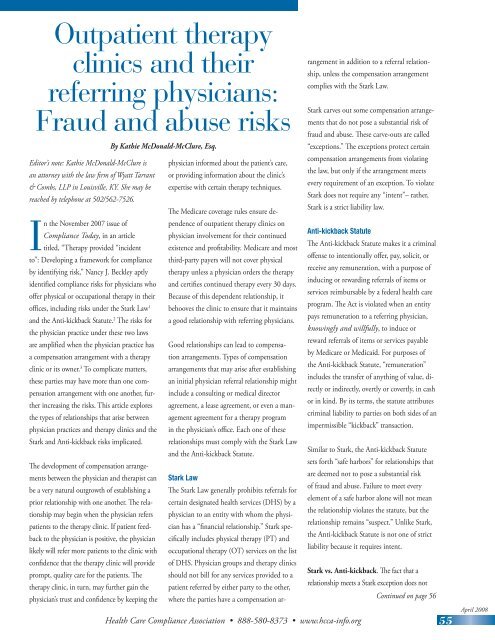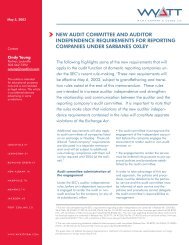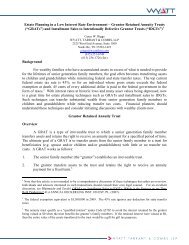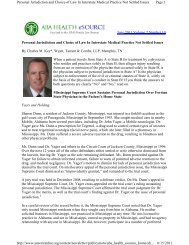Outpatient therapy clinics and their referring physicians: Fraud and ...
Outpatient therapy clinics and their referring physicians: Fraud and ...
Outpatient therapy clinics and their referring physicians: Fraud and ...
You also want an ePaper? Increase the reach of your titles
YUMPU automatically turns print PDFs into web optimized ePapers that Google loves.
<strong>Outpatient</strong> <strong>therapy</strong><strong>clinics</strong> <strong>and</strong> <strong>their</strong><strong>referring</strong> <strong>physicians</strong>:<strong>Fraud</strong> <strong>and</strong> abuse risksEditor’s note: Kathie McDonald-McClure isan attorney with the law firm of Wyatt Tarrant& Combs, LLP in Louisville, KY. She may bereached by telephone at 502/562-7526.In the November 2007 issue ofCompliance Today, in an articletitled, “Therapy provided “incidentto”: Developing a framework for complianceby identifying risk,” Nancy J. Beckley aptlyidentified compliance risks for <strong>physicians</strong> whooffer physical or occupational <strong>therapy</strong> in <strong>their</strong>offices, including risks under the Stark Law 1<strong>and</strong> the Anti-kickback Statute. 2 The risks forthe physician practice under these two lawsare amplified when the physician practice hasa compensation arrangement with a <strong>therapy</strong>clinic or its owner. 3 To complicate matters,these parties may have more than one compensationarrangement with one another, furtherincreasing the risks. This article exploresthe types of relationships that arise betweenphysician practices <strong>and</strong> <strong>therapy</strong> <strong>clinics</strong> <strong>and</strong> theStark <strong>and</strong> Anti-kickback risks implicated.The development of compensation arrangementsbetween the physician <strong>and</strong> therapist canbe a very natural outgrowth of establishing aprior relationship with one another. The relationshipmay begin when the physician referspatients to the <strong>therapy</strong> clinic. If patient feedbackto the physician is positive, the physicianlikely will refer more patients to the clinic withconfidence that the <strong>therapy</strong> clinic will provideprompt, quality care for the patients. The<strong>therapy</strong> clinic, in turn, may further gain thephysician’s trust <strong>and</strong> confidence by keeping theBy Kathie McDonald-McClure, Esq.physician informed about the patient’s care,or providing information about the clinic’sexpertise with certain <strong>therapy</strong> techniques.The Medicare coverage rules ensure dependenceof outpatient <strong>therapy</strong> <strong>clinics</strong> onphysician involvement for <strong>their</strong> continuedexistence <strong>and</strong> profitability. Medicare <strong>and</strong> mostthird-party payers will not cover physical<strong>therapy</strong> unless a physician orders the <strong>therapy</strong><strong>and</strong> certifies continued <strong>therapy</strong> every 30 days.Because of this dependent relationship, itbehooves the clinic to ensure that it maintainsa good relationship with <strong>referring</strong> <strong>physicians</strong>.Good relationships can lead to compensationarrangements. Types of compensationarrangements that may arise after establishingan initial physician referral relationship mightinclude a consulting or medical directoragreement, a lease agreement, or even a managementagreement for a <strong>therapy</strong> programin the physician’s office. Each one of theserelationships must comply with the Stark Law<strong>and</strong> the Anti-kickback Statute.Health Care Compliance Association • 888-580-8373 • www.hcca-info.orgStark LawThe Stark Law generally prohibits referrals forcertain designated health services (DHS) by aphysician to an entity with whom the physicianhas a “financial relationship.” Stark specificallyincludes physical <strong>therapy</strong> (PT) <strong>and</strong>occupational <strong>therapy</strong> (OT) services on the listof DHS. Physician groups <strong>and</strong> <strong>therapy</strong> <strong>clinics</strong>should not bill for any services provided to apatient referred by either party to the other,where the parties have a compensation arrangementin addition to a referral relationship,unless the compensation arrangementcomplies with the Stark Law.Stark carves out some compensation arrangementsthat do not pose a substantial risk offraud <strong>and</strong> abuse. These carve-outs are called“exceptions.” The exceptions protect certaincompensation arrangements from violatingthe law, but only if the arrangement meetsevery requirement of an exception. To violateStark does not require any “intent”– rather,Stark is a strict liability law.Anti-kickback StatuteThe Anti-kickback Statute makes it a criminaloffense to intentionally offer, pay, solicit, orreceive any remuneration, with a purpose ofinducing or rewarding referrals of items orservices reimbursable by a federal health careprogram. The Act is violated when an entitypays remuneration to a <strong>referring</strong> physician,knowingly <strong>and</strong> willfully, to induce orreward referrals of items or services payableby Medicare or Medicaid. For purposes ofthe Anti-kickback Statute, “remuneration”includes the transfer of anything of value, directlyor indirectly, overtly or covertly, in cashor in kind. By its terms, the statute attributescriminal liability to parties on both sides of animpermissible “kickback” transaction.Similar to Stark, the Anti-kickback Statutesets forth “safe harbors” for relationships thatare deemed not to pose a substantial riskof fraud <strong>and</strong> abuse. Failure to meet everyelement of a safe harbor alone will not meanthe relationship violates the statute, but therelationship remains “suspect.” Unlike Stark,the Anti-kickback Statute is not one of strictliability because it requires intent.Stark vs. Anti-kickback. The fact that arelationship meets a Stark exception does notContinued on page 5655April 2008
<strong>Outpatient</strong> <strong>therapy</strong> <strong>clinics</strong> <strong>and</strong> <strong>their</strong> <strong>referring</strong> <strong>physicians</strong>: ...continued from page 55automatically protect it against a finding that itcomplies with the Anti-kickback Statute, <strong>and</strong>vice versa. So, it is important to ensure arrangementscomply with both laws. The Stark Law<strong>and</strong> the Anti-kickback Statute are different inother ways besides the element of intent. Importantly,the Anti-kickback Statute is a criminalliability law that includes prison sentences <strong>and</strong>fines. Stark is a civil statute that prescribes civilmonetary penalties <strong>and</strong> fines for violations.LeasesLease arrangements invoking the Stark Law<strong>and</strong> Anti-kickback Statute arise when a <strong>referring</strong>physician (or that physician’s practicegroup) leases space to a <strong>therapy</strong> clinic. Theselaws are also invoked when the <strong>therapy</strong> clinicleases space to a <strong>referring</strong> physician or thephysician’s practice group. For purposes ofStark, such arrangements constitute either director indirect compensation, depending onthe facts. For purposes of the Anti-kickbackStatute, such arrangements would involveremuneration “in cash or in kind.”The applicable Stark exception would be the“lease of space <strong>and</strong> equipment” exception.A space lease will receive protection underStark only if each of the following six criteriais met:1. The lease must be in writing, signed bythe parties, <strong>and</strong> specify the premises<strong>and</strong> any equipment that it covers.Here, parties must ensure that the lease agreementnames, <strong>and</strong> is signed by, all <strong>physicians</strong>who have a financial interest in the propertybeing leased <strong>and</strong> who are <strong>referring</strong> patients tothe <strong>therapy</strong> clinic. In specifying the premises,the agreement should state the address, squarefootage <strong>and</strong>, preferably, attach a space plan.2. The rented space or equipment must notexceed that which is reasonable <strong>and</strong> necessaryfor the legitimate purposes of thelease <strong>and</strong> must be used exclusively by thelessee when being used by the lessee (<strong>and</strong>in the case of space rental, the lessee maypay for its use of common areas based onits pro rata share of these areas).The requirement that the lease not exceed whatis reasonable <strong>and</strong> necessary reduces the risksof abuse. For example, if a <strong>referring</strong> physicianleases space to a <strong>therapy</strong> clinic in excess ofthe amount needed <strong>and</strong> collects rental on allof the space, this may be seen as a reward orfurther inducement to the <strong>referring</strong> <strong>physicians</strong>to continue the referrals. The resulting abuseto the government program occurs when, dueto such induced referrals, services that are notmedically necessary result in overutilization ofgovernment funded services.3. The lease must be for a term of at leastone year.A month-to-month lease would not meet thisrequirement. If the lease agreement is terminatedbefore the end of a year, the parties maynot enter into a new agreement before theexpiration of the original lease. A six-monthholdover at the end of a term of at least a yearis permissible if its terms are identical to thoseof the base agreement.4. The rental charges over the term of thelease must be set in advance <strong>and</strong> must beconsistent with fair market value (FMV).To meet this requirement, it is advisable thatthe parties obtain a FMV assessment of thespace to be leased. Additionally, the lease mustspecify the actual rent or the method by whichthe parties will calculate the rent. Merelystating in the lease that the rent shall be FMV,without specifying the method or amount,places the parties at risk of failing to meet thisrequirement. In addition, this requirement alsomakes it essential to determine the square footagebeing leased, or the equivalent, in orderto demonstrate FMV. If a <strong>referring</strong> physicianis using space within the <strong>therapy</strong> clinic to seepatients on certain days of the week, then theagreement should specify precisely what spaceis being used <strong>and</strong> determine the physician’s prorata share of the total space in the clinic. (SeeSample Sublease in box.)Sample Sublease to PhysicianA written sublease of space in a <strong>therapy</strong>clinic specifies the following space is beingleased: “The Lessee [the physician] shallhave exclusive use of one private office(100 sq. ft.), two exam rooms (100 sq.ft. each) <strong>and</strong> a filing <strong>and</strong> x-ray viewingarea (50 sq. ft.) while he is present at theclinic. In addition, Lessee shall share theLessor’s [<strong>therapy</strong> clinic’s] foyer (50 sq. ft.),a common reception area (200 sq. ft.),<strong>and</strong> a common hallway leading to Lessee’soffice <strong>and</strong> exam rooms (200 sq. ft.). To theextent physician needs staff, the <strong>physicians</strong>hall provide such staff (Physician Staff)who shall be present only during the hoursset forth in this Agreement. PhysicianStaff shall utilize two work stations in theLessor’s business office area for the purposeof registering <strong>and</strong> managing the financialmatters of Lessee’s patients. The Physicianshall use the designated space on Tuesdays<strong>and</strong> Thursdays from 8:00 a.m. to 2:00p.m.” (An exhibit to the Agreement showstotal clinic space of 5,000 sq. ft.)Note that the sublease specifies whichspace is being used exclusively by thephysician <strong>and</strong> which space is part of acommon area. It also is advisable to attachan exhibit to the sublease that showshow the parties allocated the squarefootage of the physician’s space comparedwith the total square footage in eacharea <strong>and</strong> compared with the total squarefootage of the clinic. The exhibit shouldreflect the total square footage calculated<strong>and</strong> ultimately allocated to the physician,which should be used to determine theFMV of the rental payments.April 200856Health Care Compliance Association • 888-580-8373 • www.hcca-info.org
5. The rental charges cannot take into accountthe volume or value of referrals or otherbusiness generated between the parties.For example, if the <strong>therapy</strong> clinic establisheda rental amount by using a formula thatadjusts that amount based on the number ofpatient referrals from the physician, the leaseagreement would not meet this requirement.6. The lease must be commercially reasonable,even if no referrals were madebetween the parties.For example, if a <strong>therapy</strong> clinic rents spacefrom a physician group for the purposes ofproviding PT <strong>and</strong> OT services <strong>and</strong> the onlypatients treated by the <strong>therapy</strong> clinic areMedicare <strong>and</strong> Medicaid patients referred bythe physician group, the lease is not likely tobe seen as “commercially reasonable.” Thisis because the <strong>therapy</strong> clinic would have nobusiness if you take away the referrals.With the exception of Stark’s requirement for“commercial reasonableness,” the elementsof the Anti-kickback Statute’s safe harbor forspace <strong>and</strong> equipment leases are essentiallythe same as the Stark requirements above.Even though there is not room in this articleto address each of the Anti-kickback’s safeharbor requirements, it is vital to analyze theproposed lease under Anti-kickback rulesbefore it is executed.Medical director agreementsTherapy <strong>clinics</strong> often retain the services of a<strong>referring</strong> physician to act as medical directorwho will review the clinic’s services forquality-of-care issues, help develop st<strong>and</strong>ardof-carepolicies, <strong>and</strong> otherwise consult withthe clinic’s therapists regarding applicationof new <strong>therapy</strong> techniques. A clinic that isenrolled in Medicare as a Part A rehabilitationagency may want to engage a medicaldirector to help ensure that the clinic is meetingMedicare’s conditions of participation. 4Obtaining such direction from a <strong>referring</strong>physician usually involves a “compensationarrangement” that triggers Stark Law scrutiny<strong>and</strong> remuneration “in cash or in kind” <strong>and</strong>that triggers Anti-kickback Statute scrutiny.The most applicable Stark exception wouldthe “personal services arrangements” exception,<strong>and</strong> the most applicable Anti-kickbacksafe harbor would the “personal services <strong>and</strong>management contracts” safe harbor. Therequirements of the exception <strong>and</strong> the safeharbor are very similar, except for a nuanceregarding compensation noted below.To comply with Stark, the arrangementmust meet each one of the following sixrequirements:1. Be in writing, be signed by the partiesto the agreement, <strong>and</strong> specify the servicescovered by the agreement.For medical director agreements with a medicalgroup, the <strong>therapy</strong> clinic should ensurethat all doctors who have or may refer servicesto the clinic are named as parties to the agreement<strong>and</strong> sign it.2. Cover all of the services to be furnishedby the physician (or an immediate familymember) to the <strong>therapy</strong> clinic.This condition requires either a cross-referencein the agreement to other compensation arrangementsor maintenance of a master list bythe parties of such other arrangements. This canbe done by including an exhibit to the agreementthat lists all compensation arrangementsthat the <strong>therapy</strong> clinic has with the physician (oran immediate family member). One risk is thatthe parties may fail to list another compensationarrangement, because they simply werenot aware of it. For example, the <strong>therapy</strong> cliniccould have a lease with ABC Realty, LLC for itsclinic space. Because many <strong>physicians</strong> are ownersor investors in buildings used for medicalservices, the parties should determine whetherone or more owners of ABC Realty, LLC includesa <strong>referring</strong> physician. (To reduce the riskof the unknown, before entering any space leaseagreement, the parties should fully disclose allowners of the space.)3. The aggregate services must not exceedthose that are reasonable <strong>and</strong> necessaryfor the legitimate purposes of the arrangement.Types of services that would certainly bereasonable <strong>and</strong> necessary for a <strong>therapy</strong> clinicwould include assisting in ensuring the qualityof the <strong>therapy</strong> services being provided. Themedical director could participate in reviewingpatient charts, plans of care, the progress oftreatment <strong>and</strong> the patient’s compliance withtreatment. The medical director could reviewpolicies <strong>and</strong> procedures related to the deliveryof care at the clinic <strong>and</strong> provide clinicaleducation on topics germane to the practiceat the clinic. Allowing the medical director toadvertise or promote his medical services topatients of the <strong>therapy</strong> clinic, however, wouldnot be deemed reasonable <strong>and</strong> necessary to thelegitimate purposes of the arrangement.4. The term must be at least one year.Again, if terminated during the initial year,the parties may not enter into the same orsubstantially the same arrangement before theend of the initial term.5. The compensation must be determinedin advance, not exceed FMV, <strong>and</strong> not bedetermined by the volume or value ofany referrals or other business generatedbetween the parties.As with rental payments discussed earlier,the compensation should be documentedin a way that can be objectively <strong>and</strong> readilyascertained from the face of the agreement.The parties should specify the aggregatecompensation, or a time-based or per unit ofservice-based amount, or a specific formulaContinued on page 59Health Care Compliance Association • 888-580-8373 • www.hcca-info.org57April 2008
<strong>Outpatient</strong> <strong>therapy</strong> <strong>clinics</strong> <strong>and</strong> <strong>their</strong> <strong>referring</strong> <strong>physicians</strong>: ...continued from page 57for calculating the compensation in a waythat can be objectively verified to be in linewith FMV. FMV assessments often requirethe expertise of an appraiser with experiencein valuing physician compensation arrangements,so it is advisable to consult with one. 5If the <strong>therapy</strong> clinic has subleased space to themedical director, as in the example discussedabove, make certain that the invoiced servicesdo not include dates <strong>and</strong> times when thephysician was providing services in his ownpractice in the subleased clinic space.The Anti-Kickback safe harbor differs fromthe Stark exception in that the safe harborrequires that the “aggregate” compensationpaid over the term of the agreement be setin advance. The safe harbor further requiresthat the agreement specify an exact schedulefor services that are periodic, sporadic, orpart-time, <strong>and</strong> that the precise length of time<strong>and</strong> exact charge for each interval be stated. Ifthe medical director’s services are to be paidon an hourly basis, as many are, <strong>and</strong> invoicedmonthly according to the hours worked toperform the services, the parties will not beable to “aggregate” or total these services,because the services have not even been providedyet! However, the inability to meet thissafe harbor requirement does not mean thatthe agreement is illegal; rather, it’s simply not“safe.” Even if the parties decide to establishan annual compensation rate for the medicaldirector’s services, it is advisable to require themedical director to document the services hehas provided each month <strong>and</strong> to retain thisdocumentation so that his or her services canbe quantified in case of a future audit.6. The services do not counsel or promotea business arrangement or other activitythat violates any state or federal law, suchas the federal Anti-kickback Statute.For example, if the medical director agreementis designed to financially benefit the physician’sexisting practice by inducing <strong>and</strong> increasingreferrals, there may be problems in paradise.Management agreementsWe have covered personal services from the<strong>referring</strong> physician to the <strong>therapy</strong> clinic.What about services from the <strong>therapy</strong> clinicto the <strong>referring</strong> physician? The Stark <strong>and</strong>Anti-Kickback laws have implications for a<strong>therapy</strong> company that provides <strong>therapy</strong> programmanagement services in the office of thephysician. This is an area where the Stark <strong>and</strong>Anti-kickback laws part ways in terms of theelements that must be present to be protectedor “safe.” The applicable Stark exception isthe “in-office ancillary services” exception.Under Stark, designated health services, suchas PT <strong>and</strong> OT, must be furnished “personally”by the physician in the physician’s offices ora “centralized building” used by the “grouppractice” for the provision of some or all ofthe practice’s DHS services. The applicableAnti-kickback safe harbor is the “personalservices <strong>and</strong> management contracts” safeharbor, the same safe harbor (discussed above)applicable to medical director agreements.Several basic terms should be consideredwhen formulating the <strong>therapy</strong> services managementagreement between the <strong>therapy</strong>clinic <strong>and</strong> the physician practice. Getting theterms right could make the road smootherfor both parties <strong>and</strong> defend the legality of thearrangement. Note: These pointers shouldnot be viewed as a recitation of specific StarkLaw <strong>and</strong> Anti-kickback Statute requirements,but rather, for the sake of brevity only, areintended to reduce the most salient requirementsof the complex in-office ancillaryservices exception into contract terms. Thesecontract term pointers are as follows:1. Require claims be filed under the Medicareprovider number of the physicianpractice (not the <strong>therapy</strong> clinic);2. Require the physician practice to retainthe exclusive authority <strong>and</strong> ultimateresponsibility over the billing <strong>and</strong> collectionof services provided in the <strong>therapy</strong>program, including repayment of anyoverpayments by Medicare, Medicaid,<strong>and</strong> other third-party payers; 63. Set the aggregate compensation for the<strong>therapy</strong> company’s management servicesin advance;4. Require the physician practice to retainownership <strong>and</strong> exclusive control over the<strong>therapy</strong> program;5. Require that the physician practice ensure<strong>therapy</strong> staff are properly licensed <strong>and</strong>compliant with HIPAA; 76. Require the physician practice to assumethe duty <strong>and</strong> responsibility of ensuringcontinuing compliance with Stark, particularlythe “in-office ancillary services”exception, including:a. That the physician practice constitutesa “group practice”;b. That a physician who is a member ofthe physician practice directly supervisesthe individuals who provide servicesas part of the <strong>therapy</strong> program<strong>and</strong> otherwise meets all applicableMedicare payment <strong>and</strong> coverage rules(i.e., “incident to”);c. That the physician practice will ensurethat the <strong>therapy</strong> services are providedin a building that meets the StarkLaw exception’s “centralized building”requirement.Why place the onus of Stark compliance on thephysician practice? Because if this arrangementis to go forward, the physician must complywith Stark’s “in-office ancillary services” exception;<strong>and</strong> this is an exception with elementsover which the <strong>therapy</strong> practice may havelittle or no control. Why not go for another,less onerous exception under Stark? Becausethe Stark Law requires that compensationContinued on page 60Health Care Compliance Association • 888-580-8373 • www.hcca-info.org59April 2008
<strong>Outpatient</strong> <strong>therapy</strong> <strong>clinics</strong> <strong>and</strong> <strong>their</strong> <strong>referring</strong> <strong>physicians</strong>: ...continued from page 59arrangements comply with the most applicableexception <strong>and</strong>, in the majority of situations, thisis the most applicable exception. The personalservices exception that applied to medicaldirector services does not apply to the <strong>therapy</strong>management services because, among otherreasons, the remuneration under this arrangementis running from the physician practice tothe <strong>therapy</strong> clinic rather than vice versa, as wasthe case with the medical director agreementabove. It would be nice if we could apply a lesscomplex exception, if only to make the analysiseasier – but Stark is neither nice nor easy.regulations as of November 5, 2007.Of particular relevance to the scope of thisarticle is Stark’s revised “direct compensation”definition that now utilizes a “st<strong>and</strong> in theshoes” test. In essence, <strong>physicians</strong> who aremembers, employees, or independent contractorsof a physician organization now st<strong>and</strong>in the shoes of <strong>their</strong> physician organization.As a result, each individual physician of thatorganization is now deemed to have the samecompensation arrangement with other DHSentities that <strong>their</strong> physician organization has.In structuring the management servicesarrangement, keep in mind that this is asituation where the physician group desires toprovide ancillary services for which it can bereimbursed. As a result, instead of <strong>referring</strong>patients to a third-party DHS entity, the<strong>physicians</strong> in this arrangement are <strong>referring</strong>patients to themselves, (i.e., the true essenceof “self-referrals”). The <strong>therapy</strong> clinic is beingengaged to manage those services in exchangefor a pre-established fee. Even though thegreatest risk under Stark would appear to bewith the physician practice, because of theprohibition on physician self-referrals billedto Medicare that do not fit within a Starkexception, Stark imposes liability on bothparties to a prohibited self-referral arrangement.Accordingly, the <strong>therapy</strong> clinic cannotrest easy simply by placing the onus on thephysician practice to ensure Stark compliance.A final cautionOn September 5, 2007, the Centers forMedicare <strong>and</strong> Medicaid Services (CMS)released the Stark II Phase III regulations, 8effective November 5, 2007. 9 Contracts thatwere in compliance with Stark as of September5, 2007, were gr<strong>and</strong>fathered in, until thedate of <strong>their</strong> expiration or renewal. Otherwise,financial arrangements with <strong>physicians</strong>should have been in compliance with the newAccordingly, existing compensation arrangementsbetween <strong>therapy</strong> <strong>clinics</strong> <strong>and</strong> physicianpractices should be immediately reviewed toensure they comply in light of the new rules.For example, if the <strong>therapy</strong> clinic had a compensationarrangement with a physician organizationas a whole, that arrangement is nowwith every physician individually. To bringsuch an agreement into compliance, the partiesshould ensure that all individual <strong>physicians</strong>who refer (or are likely to refer) patients to the<strong>therapy</strong> clinic are named as parties to, <strong>and</strong> havesigned, the medical director agreement.1 Ethics in Patient Referrals Act, colloquially known as “Stark,” 42 U.S.C.§1395nn.2 Anti-kickback Statute, 42 U.S.C. § 1320a-7b.3 Under Medicare, outpatient <strong>therapy</strong> can be provided in one of twoforms: Rehabilitation Agency under Part A or Physical or OccupationalTherapy Group (or Individual) in Private Practice under Part B. Forconvenience, I use “Therapy Clinic” to refer to both forms.4 Conditions of Participation for <strong>Outpatient</strong> Rehabilitation Agencies canbe found at 42 CFR 485.701 et. seq.5 The Stark II Phase III regulations released on September 5, 2007,eliminated the FMV “exception” in the prior Stark II Phase II regulationthat set forth two methodologies for determining the FMV of an hourlypayment. Nevertheless, Phase III noted that it would still recommendusing multiple, objective, independently published salary surveys todetermine FMV of the hourly rate.6 The <strong>therapy</strong> program manager could, however, agree to act as the billingagent of the physician under the number assigned to the physician orphysician practice.7 Whether the physician practice can actually employ the therapist maybe controlled by state law. In South Carolina, a physical therapist isstatutorily prohibited from working as an employee of a physician whorefers patients to the physical therapist. See Sloan v. S.C. Bd. of PhysicalTherapy Exam’rs, 370 S.C. 452 (S.C. 2006). The Delaware AttorneyGeneral similarly interpreted the Delaware State Physical TherapyPractice Act. See AG 02-IB25 (10/10/02).8 42 CFR Parts 411 <strong>and</strong> 424, published in the Fed. Reg., Vol. 72 No.171, Wednesday, September 5, 2007.9 Although CMS suspended the effective date of the revised directcompensation definition for certain providers, such suspension does notinclude outpatient <strong>therapy</strong> <strong>clinics</strong>.NOTE: This article, published in the April2008 issue of Compliance Today, appearshere with permission from the Health CareCompliance Association. Contact HCCA at888/580-8373 with reprint requests.April 200860Health Care Compliance Association • 888-580-8373 • www.hcca-info.org











